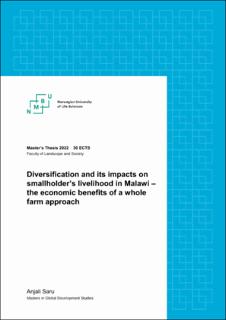| dc.description.abstract | Malawi is the sixth poorest country in the world, and its citizens are especially vulnerable to climate change since they are concentrated in rural areas and rely on agriculture that is highly dependent on rain. Farmers' inability to enhance their standard of living and the depletion of nutrients for ordinary calorie consumption is exacerbated by the fact that they consume the majority of their production—maize being the staple crop. It seems that smallholders in Malawi would benefit from a "whole farm approach," which seeks to build a profitable base to bear fluctuating market conditions and to transition traditional crops into high valued cash crops. The integrated crop and livestock system in Malawi is still uncharted, despite the fact that sweet potato, cassava, soybean, and other crops are being adapted. Furthermore, the populace is also engaged in occupations apart than farming. Therefore, it becomes difficult for smallholders to choose between potentially high-profit but low-risk ventures. This study explores to understand the impact of whole farm approach and economic benefits based on different crops and livestock combination. Around 470 individuals were selected from the pool of 1100 farmers based on their primary and second importance source of income namely crops, labor and livestock from Dowa district, Malawi. The semi-structured questionnaire were asked by qualified field research assistants to extract demography, quantity related to growing crops and livestock and income surrounding them. The study's findings suggested that the biggest returns might be expected from the sale of Irish potatoes and vegetables, while crop cultivation alongside livestock served as a secondary source of income for practically every item. Cattle stood highest yielder from livestock farming. The whole farm approach (diversification) has the potential to increase economic resilience in smallholders. | en_US |

